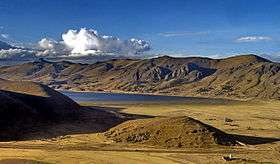Suni (geography)
Suni or Jalca is one of the eight Natural Regions of Peru. It is located in the Andes at an altitude between 3,500 and 4,000 metres above sea level. Suni has a dry and cold weather and there are many glacial valleys.

Chacas lagoon, Puno, Peru
Flora and fauna
The flora includes gramineous plants and shrubs such as the taya-taya (Caesalpinia spinosa), the quishuar (Buddleja coriacea), and the cantuta (Cantua buxifolia) which was considered sacred by the Incas.
Even though it is hard for plants to grow because of the weather, people are able to cultivate such crops as quinoa, maca, qañiwa, broad beans and ulluku (Ullucus tuberosus).
The main fauna is the guinea pig and, among numerous other highland birds, the Chiguanco thrush.[1]
Overview

Quinoa, a flora species.
Andean Continental Divide
| Westside | Eastside |
|---|---|
| Chala, dry coast | Lowland tropical rainforest or Selva baja |
| Maritime Yungas | Highland tropical rainforest or Selva alta |
| Maritime Yungas | Subtropical cloud forest or Fluvial Yungas |
| Quechua - montane valleys | Quechua - montane valleys |
| Tree line | Tree line - about 3,500 m |
| Suni, scrubs and agriculture | Suni, scrubs and agriculture |
Mountain top:
- Mountain passes - 4,100 m
- Puna grassland
- Andean-alpine desert
- Snow line - about 5,000 m
- Janca - rocks, snow and ice
- Peak
gollark: --apioform
gollark: --apioform
gollark: --apioform
gollark: --exec --bees ```pythonprint("--remind 1m test")```
gollark: --exec --bees ```pythonprint("--remind 1m test")```
See also
- Climate zones by altitude
- Altitudinal zonation
Literature
- Pulgar Vidal, Javier: Geografía del Perú; Las Ocho Regiones Naturales del Perú. Edit. Universo S.A., Lima 1979. First Edition (his dissertation of 1940): Las ocho regiones naturales del Perú, Boletín del Museo de historia natural „Javier Prado“, n° especial, Lima, 1941, 17, pp. 145-161.
This article is issued from Wikipedia. The text is licensed under Creative Commons - Attribution - Sharealike. Additional terms may apply for the media files.